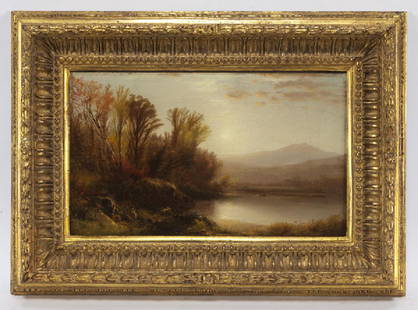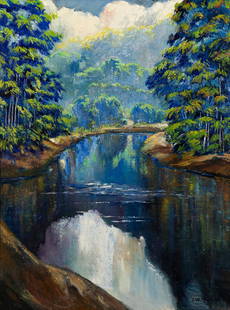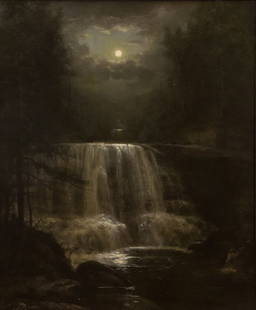
George Barrett Snr RA (c.1730 - 1784) Sun Rising: An Extensive Wooded Landscape with Fishermen Oil
Similar Sale History
View More Items in Paintings
Related Paintings
More Items in Paintings
View MoreRecommended Art
View More




Item Details
Description
George Barrett Snr RA (c.1730 - 1784) Sun Rising: An Extensive Wooded Landscape with Fishermen Oil on canvas, 101.5 x 126 cm (40 x 49½) Engraved: by Robert Laurie (Fig 2), published by Robert Sayer and John Bennet, No 53 Fleet Street, London, 10 July 1774 Literature: Taking Stock, Acquisitions, 2000-2010, Exhibition Catalogue, National Gallery of Ireland (Dublin, 2009) p. 13: ‘a smaller but equally high-quality version of this picture recently appeared on the London art market’ One of the most compellingly dramatic paintings by George Barret, and a masterpiece of eighteenth-century Irish art, this landscape has recently been identified as a painting entitled in the artist’s lifetime Sun Rising. Here, in a work directly inspired by the beauties of the Wicklow landscape, Barret offers a magically rendered account of the moment when, at dawn, the sun emerges anew. Since the builders of Newgrange, sunrise has acquired associations with myth and religion and become richly freighted with symbolic charge – hope for renewal, rebirth or even resurrection. While playing with these multiple and complex resonances, Barret also evokes with great bravura of technique the sheer wonder that dawn presents and offers us a masterly rendering on canvas of the elemental beauty of nature. The painting relates directly to a somewhat larger work in the National Gallery of Ireland, (Christie’s 12/5/2005, £512,000, approx. €615,000) (fig. 1). That the present work is the prototype of the composition and the NGI picture a later reworking, seems apparent from the presence here of distinct pentimenti – signs of where the artist has changed his mind while working on the canvas – and also the evidence of an engraving by Robert Laurie made in 1774 some years after the work was painted (fig 2). This shows two figures in the boat in the foreground (as here), rather than single figure as in the National Gallery of Ireland painting, clearly indicating from which work it was taken. The larger NGI painting, painted on an anomalously sized canvas, is likely to have been a commission to rework this successful composition for a specific location. The print is titled Sun-Rising, and presumably was so christened with Barret’s blessing as he must have made his composition available to the printmaker to copy, or encouraged its purchaser to lend it. Indeed the engraving is a great rarity as its seems to be the only print commissioned after one of his Irish, or Irish-inspired, paintings, suggesting that it was a landscape with which Barret was particularly pleased and proud. Barret, born in Dublin’s Liberties, rose to be one of the most successful landscape painters in eighteenth-century London, and a founding member of the Royal Academy. Here by looking at nature afresh he moves beyond the classical tradition of followers of Claude like Richard Wilson and shows himself a proto-Romantic and, indeed, an important precursor of Turner. This is most apparent in the swirling vortex of light almost entirely surrounded by cloud, a compositional device (with pronounced symbolic charge) that Turner in his late period – many decades later – would take further. Here Barret stands as a pioneer of European landscape art. This aspect of Barret’s practice was astutely commented on by his friend Edmund Burke. Burke writes how the artist: ‘presents you with such a glorious assemblage, as I have sometimes seen among high mountains rising into unusual agreeable appearances while the early beams of the sun sport themselves ... through the vast arcades and sometimes glances on a great lake whose ascending vapours spread themselves like a veil over the distance’. Burke could have been specifically thinking of the present work in which ‘the early beams of the sun’ are individually visible. Writing of the National Gallery of Ireland replica Brendan Rooney notes how it is a ‘profoundly atmospheric painting, the apparent serenity of the river and relaxed activity of the figures upon it are countered by a sunburst that breaks though the trees to the left and the huge, ominous arc of cloud that glowers over the scene’. As Dr Rooney notes, the composition ‘owes a considerable debt to the artist’s experience working in the Dargle Valley’, in county Wicklow. Until recent research made the obvious link with the NGI work, and, indeed, the engraving, the present picture was described quite inaccurately as a Welsh view, ‘Llanberis and Dolbadarn Castle’. It is unclear if a specific location in Wicklow is intended. Perhaps most likely it is based on sketches made in the Dargle Valley worked into a pleasing but not topographically accurate whole. Described by one contemporary visitor as ‘most exceedingly romantic and beautiful’, the scenery of the Dargle which inspired Barret here was instrumental in the swift rise of the Dublin School of Irish landscape painting, pioneered by Barret in the 1750s and ‘60s. Under the patronage of Viscount Powerscourt, and the inspiration of Edmund Burke, Barret painted repeatedly in the area. The Dargle scenery continued to inspire Barret and his first two exhibits in the Society of Artists in London in 1764 were of the Powerscourt Waterfall and the Dargle River. Dr Rooney suggests this juncture in Barret’s career as the date of the present composition, when the young Irish artist, recently arrived in London, was still inspired by the Wicklow scenery with which he had recently so fruitfully engaged. Equally, it is possible that this is one of the paintings that Barret brought with him from Dublin to London. We thank Logan Morse for her assistance in preparing this catalogue entry.
Buyer's Premium
- 30%
George Barrett Snr RA (c.1730 - 1784) Sun Rising: An Extensive Wooded Landscape with Fishermen Oil
Estimate €100,000 - €150,000
1 bidder is watching this item.
Shipping & Pickup Options
Item located in Ireland, Dublin, ieSee Policy for Shipping
Payment

TOP










































![Emilio Grau-Sala "Sur la Plage" Oil on Canvas: Emilio Grau-Sala (Spanish, 1911-1975), "Sur la Plage" [On The Beach], Oil on Canvas, 1958, signed "Grau Sala" lower right, signed, inscribed "Trouville", dated, and titled to verso. Image: 21.5" H x 2](https://p1.liveauctioneers.com/5649/328023/176731071_1_x.jpg?height=310&quality=70&version=1714409606)













![[SEX] LOT OF 9 PHOTOGRAPHS SOLD TOGETHER: [SEX] A lot of 9 photographs sold together. Some postcards. One mounted with plastic corners in archival mat. Prints: 4.5" x 3" - 6" x 4". Generally good condition, various imperfections. *Additional](https://p1.liveauctioneers.com/8124/329546/177689790_1_x.jpg?height=310&quality=70&version=1715469494)



